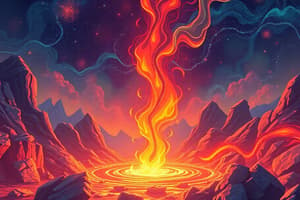Podcast
Questions and Answers
How does an increase in volume typically affect the density of a substance, assuming mass remains constant?
How does an increase in volume typically affect the density of a substance, assuming mass remains constant?
- Density remains the same.
- Density decreases. (correct)
- Density fluctuates randomly.
- Density increases proportionally.
A metal rod is heated. Which type of thermal expansion is most relevant to consider for its change in size?
A metal rod is heated. Which type of thermal expansion is most relevant to consider for its change in size?
- Areal expansion, affecting the surface area.
- No thermal expansion occurs.
- Volumetric expansion, affecting the overall volume.
- Linear expansion, primarily affecting the length. (correct)
What happens to the total kinetic energy of the molecules in a system as it approaches thermal equilibrium?
What happens to the total kinetic energy of the molecules in a system as it approaches thermal equilibrium?
- The total kinetic energy increases exponentially.
- The total kinetic energy decreases to zero.
- The total kinetic energy redistributes until it is evenly distributed. (correct)
- The total kinetic energy remains constant but is unevenly distributed.
A 2 kg block of metal requires 5000 J of heat to raise its temperature by 2 degrees Celsius. Calculate the specific heat capacity of the metal using the formula $Q = mc\Delta T$, where Q is heat, m is mass, c is specific heat capacity and $ \Delta T $ is change in temperature.
A 2 kg block of metal requires 5000 J of heat to raise its temperature by 2 degrees Celsius. Calculate the specific heat capacity of the metal using the formula $Q = mc\Delta T$, where Q is heat, m is mass, c is specific heat capacity and $ \Delta T $ is change in temperature.
Why is water often used to cool other materials, such as in beverage cooling systems?
Why is water often used to cool other materials, such as in beverage cooling systems?
What phenomenon is primarily responsible for the buckling of railroad tracks, as depicted in Figure 1?
What phenomenon is primarily responsible for the buckling of railroad tracks, as depicted in Figure 1?
According to the information provided, what fundamental behavior do atoms and molecules exhibit within a solid?
According to the information provided, what fundamental behavior do atoms and molecules exhibit within a solid?
If a material experiences a significant decrease in temperature, what change would most likely occur based on the concept of thermal expansion?
If a material experiences a significant decrease in temperature, what change would most likely occur based on the concept of thermal expansion?
During which years did train derailments caused by rail buckling reach a concerning number in the US?
During which years did train derailments caused by rail buckling reach a concerning number in the US?
What is thermal equilibrium?
What is thermal equilibrium?
Why is it important to consider thermal expansion when constructing long structures like bridges and railways?
Why is it important to consider thermal expansion when constructing long structures like bridges and railways?
If a metal rod's temperature increases, which of the following is the most likely immediate effect on its atoms?
If a metal rod's temperature increases, which of the following is the most likely immediate effect on its atoms?
How does the concept of thermal expansion relate to the design and safety of railway systems?
How does the concept of thermal expansion relate to the design and safety of railway systems?
A metal rod is heated uniformly. Which of the following statements best describes the change at the molecular level?
A metal rod is heated uniformly. Which of the following statements best describes the change at the molecular level?
A bridge is constructed with small gaps between its sections. What is the primary reason for including these gaps?
A bridge is constructed with small gaps between its sections. What is the primary reason for including these gaps?
A bimetallic strip, composed of two different metals with different coefficients of thermal expansion, is heated. What will happen to the strip?
A bimetallic strip, composed of two different metals with different coefficients of thermal expansion, is heated. What will happen to the strip?
Which of the following scenarios demonstrates phase change requiring the greatest amount of energy, assuming equal mass?
Which of the following scenarios demonstrates phase change requiring the greatest amount of energy, assuming equal mass?
A sealed, rigid container is filled with water. If the container is heated, what will happen to the pressure inside?
A sealed, rigid container is filled with water. If the container is heated, what will happen to the pressure inside?
A balloon is filled with air at room temperature. What happens to the balloon's volume when it is placed in a freezer?
A balloon is filled with air at room temperature. What happens to the balloon's volume when it is placed in a freezer?
Substance A has a higher specific heat capacity than Substance B. If equal masses of both substances are heated with the same amount of energy, which substance will experience a smaller temperature change?
Substance A has a higher specific heat capacity than Substance B. If equal masses of both substances are heated with the same amount of energy, which substance will experience a smaller temperature change?
During a phase change, such as melting ice, what happens to the energy being added to the substance?
During a phase change, such as melting ice, what happens to the energy being added to the substance?
Using the formula $Q = mH_v$, if you double the mass of a liquid being vaporized, what happens to the amount of heat required?
Using the formula $Q = mH_v$, if you double the mass of a liquid being vaporized, what happens to the amount of heat required?
What is the physical significance of the freezing and boiling points of a substance?
What is the physical significance of the freezing and boiling points of a substance?
A container holds a mixture of ice and water at 0°C. If heat is added to the container, what is the immediate effect?
A container holds a mixture of ice and water at 0°C. If heat is added to the container, what is the immediate effect?
If 500 g of water at 100°C is converted to steam at 100°C, and then the steam is further heated to 110°C, which process requires the most energy?
If 500 g of water at 100°C is converted to steam at 100°C, and then the steam is further heated to 110°C, which process requires the most energy?
When calculating the total heat needed to convert ice at -20°C to steam at 120°C, which of the following steps is NOT required?
When calculating the total heat needed to convert ice at -20°C to steam at 120°C, which of the following steps is NOT required?
A substance requires 2000 J of heat to change from a solid to a liquid at its melting point. The same substance then requires 10,000 J of heat to change from a liquid to a gas at its boiling point. What can be inferred?
A substance requires 2000 J of heat to change from a solid to a liquid at its melting point. The same substance then requires 10,000 J of heat to change from a liquid to a gas at its boiling point. What can be inferred?
A scientist performs an experiment to determine the heat of vaporization of a new substance. Which of the following measurements are most critical for accurately calculating the heat of vaporization?
A scientist performs an experiment to determine the heat of vaporization of a new substance. Which of the following measurements are most critical for accurately calculating the heat of vaporization?
Two different liquids with equal masses are heated at the same rate. Liquid A vaporizes completely in 10 minutes, while Liquid B vaporizes completely in 15 minutes. What does this indicate about their heats of vaporization?
Two different liquids with equal masses are heated at the same rate. Liquid A vaporizes completely in 10 minutes, while Liquid B vaporizes completely in 15 minutes. What does this indicate about their heats of vaporization?
A 2.0 kg block of ice at 273 K ($0^\circ$C) is placed in a calorimeter. If the heat of fusion of ice is $3.34 \times 10^5$ J/kg, how much heat is required to completely melt the ice into water at 273 K?
A 2.0 kg block of ice at 273 K ($0^\circ$C) is placed in a calorimeter. If the heat of fusion of ice is $3.34 \times 10^5$ J/kg, how much heat is required to completely melt the ice into water at 273 K?
If 3.6 x $10^6$ J of energy are equivalent to 1 kWh, what is the cost of using 5 kWh of electricity if the price is P10.00 per kWh?
If 3.6 x $10^6$ J of energy are equivalent to 1 kWh, what is the cost of using 5 kWh of electricity if the price is P10.00 per kWh?
A metal rod requires 5000 J of heat to raise its temperature from 20C to 60C. If the same rod requires 12,500 J of heat to raise its temperature from 20C to an unknown final temperature, what is the final temperature?
A metal rod requires 5000 J of heat to raise its temperature from 20C to 60C. If the same rod requires 12,500 J of heat to raise its temperature from 20C to an unknown final temperature, what is the final temperature?
A 0.5 kg block of aluminum at 20C absorbs 8400 J of heat. Given that the specific heat capacity of aluminum is 900 J/kgK, what is the final temperature of the aluminum block?
A 0.5 kg block of aluminum at 20C absorbs 8400 J of heat. Given that the specific heat capacity of aluminum is 900 J/kgK, what is the final temperature of the aluminum block?
Which process requires the greatest amount of energy for a 1 kg substance?
Which process requires the greatest amount of energy for a 1 kg substance?
500 grams of water at 20C is heated until it reaches 80C. How much heat is required for this process, if the specific heat capacity of water is 4186 J/kgK?
500 grams of water at 20C is heated until it reaches 80C. How much heat is required for this process, if the specific heat capacity of water is 4186 J/kgK?
A 0.2 kg piece of metal at 85C is placed in 0.3 kg of water at 25C. The final temperature of the water and metal is 30C. Assuming no heat is lost to the surroundings, what is the specific heat capacity of the metal? (Specific heat capacity of water is 4186 J/kgK)
A 0.2 kg piece of metal at 85C is placed in 0.3 kg of water at 25C. The final temperature of the water and metal is 30C. Assuming no heat is lost to the surroundings, what is the specific heat capacity of the metal? (Specific heat capacity of water is 4186 J/kgK)
How does the total kinetic energy of molecules change during a phase change from liquid to gas at constant temperature?
How does the total kinetic energy of molecules change during a phase change from liquid to gas at constant temperature?
Flashcards
Thermal Expansion
Thermal Expansion
The increase in volume of matter when heated.
Phase Change
Phase Change
The transition of matter between solid, liquid, and gas states due to temperature changes.
Temperature Change
Temperature Change
The alteration in thermal energy of a substance, often leading to physical changes.
Kinetic Energy
Kinetic Energy
Signup and view all the flashcards
Initial State of Matter
Initial State of Matter
Signup and view all the flashcards
Final State of Matter
Final State of Matter
Signup and view all the flashcards
Volume Increase
Volume Increase
Signup and view all the flashcards
Molecular Level Changes
Molecular Level Changes
Signup and view all the flashcards
Railroad Track Buckling
Railroad Track Buckling
Signup and view all the flashcards
Equilibrium Point
Equilibrium Point
Signup and view all the flashcards
Atoms and Molecules Oscillation
Atoms and Molecules Oscillation
Signup and view all the flashcards
Temperature Effect
Temperature Effect
Signup and view all the flashcards
Train Derailments
Train Derailments
Signup and view all the flashcards
U.S. Train Derailments (1998-2002)
U.S. Train Derailments (1998-2002)
Signup and view all the flashcards
Density and Volume
Density and Volume
Signup and view all the flashcards
Thermal Expansion Types
Thermal Expansion Types
Signup and view all the flashcards
Specific Heat Capacity
Specific Heat Capacity
Signup and view all the flashcards
Specific Heat Formula
Specific Heat Formula
Signup and view all the flashcards
Water as a Cooling Material
Water as a Cooling Material
Signup and view all the flashcards
Heat absorbed by water
Heat absorbed by water
Signup and view all the flashcards
Heat of Fusion
Heat of Fusion
Signup and view all the flashcards
Heat of Vaporization
Heat of Vaporization
Signup and view all the flashcards
Specific Heat
Specific Heat
Signup and view all the flashcards
KWH to Joules
KWH to Joules
Signup and view all the flashcards
Mass and Heat Transfer
Mass and Heat Transfer
Signup and view all the flashcards
Heating Metal
Heating Metal
Signup and view all the flashcards
Phase Change vs Temperature
Phase Change vs Temperature
Signup and view all the flashcards
Heat Required Equation
Heat Required Equation
Signup and view all the flashcards
Freezing Point
Freezing Point
Signup and view all the flashcards
Boiling Point
Boiling Point
Signup and view all the flashcards
Heat Absorption
Heat Absorption
Signup and view all the flashcards
Study Notes
Effects of Heat on Matter
- The effects of heat on matter include thermal expansion, phase change, and temperature change.
- Thermal expansion is matter's tendency to change volume in response to temperature changes. When heated, particles vibrate more and move further apart, increasing volume.
- An example of thermal expansion is the buckling of railroad tracks due to temperature changes.
- Atoms and molecules within a solid constantly oscillate around their equilibrium point.
- Particles in a solid vibrate slightly; in a liquid, they vibrate more and move around; in a gas, they move rapidly in all directions.
- An increase in volume leads to a decrease in density.
- Thermal expansion can be linear, areal, or volumetric. These are different ways matter expands in response to heat.
- Different materials have different expansion coefficients, which quantify how much they expand for a given temperature change. These coefficients vary by material.
Lesson Objectives
- The lesson aims to enumerate and explain the effects of heat on matter.
- The effects include thermal expansion, phase changes, and temperature changes.
Activity One
- The activity involves predicting, observing, and explaining phenomena related to heat.
- The concepts of total kinetic energy and equilibrium are crucial in this activity.
Instructions
- Students are instructed to predict the outcome of a given situation.
- Next, observe the real outcome to see if predictions were accurate.
- Finally, explain the reason for the outcome.
Questions
- Question One: Initial state of a spherical metal object prior to heating.
- Question Two: State of the metal ball after heating.
- Question Three: Reasoning behind the metal's increased volume after heating.
- Question Four: Explanation of what occurs at the molecular level during heating.
Thermal Expansion
- Thermal expansion describes the increase in the size of a material when heated.
- Thermal expansion has applications in various fields.
- The table from page 16 lists different materials and corresponding thermal expansion coefficients at 20°C.
Density and Volume
- The Density formula is D= m/V, where D = Density, m = mass and V = volume.
- An increase in volume correlates with a decrease in density.
Thermal Expansion of Solids
- Solids vibrate slightly before heating and have atoms in fixed positions, becoming more active with vibrations and spreading out when heated.
Density and Volume
- Density is mass per unit volume
- Increased volume results in lowered density
Change in Temperature
- Heat changes the temperature of a system or object.
Specific Heat Capacity
- Specific heat capacity is the amount of heat needed per unit mass to change a substance's temperature by one degree.
- The equation for heat transfer given specific heat capacity is Q = m x c x ΔT
- Q is the heat required.
- m is the mass of the substance.
- c is the specific heat capacity.
- ΔT is the change in temperature.
- The table given on page 20 describes specific heat capacities for various materials.
Phase Change
-
A phase change is a physical transformation from one state to another in matter (solid, liquid, or gas).
-
The heat of fusion (Hf) is the heat required to change a solid into a liquid. The equation is Q = mHf.
-
The heat of vaporization (Hv) is the heat required to change a liquid into a gas. The equation is Q = mHv.
Freezing Point and Boiling Point
- Freezing point and boiling point temperatures represent the phase transitions of a substance, at which thermal energy shifts into/out of the substance as the matter makes the phase transition.
- Matter does not adjust its rate of particle motion (kinetic energy), but rather how the particles interact at those points.
Sample Problems
- Sample problems on pages 23, 24, 25, 26, 36, 37, 38, and 39 demonstrate problem-solving methods related to heat transfer, thermal expansion, and phase changes for various substances.
Studying That Suits You
Use AI to generate personalized quizzes and flashcards to suit your learning preferences.




